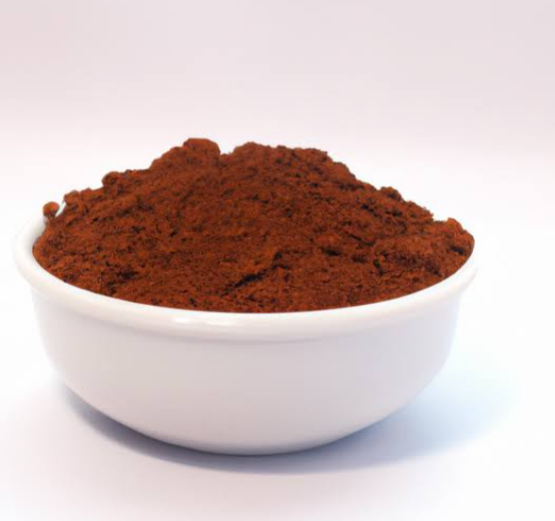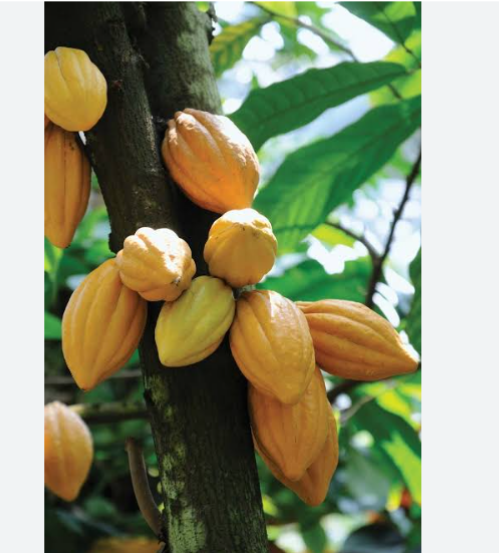
Cocoa is an important commodity in the world trade. It developed at the Amazon region of Latin America. Christopher Columbus discovered Cocoa on his 14th voyage to America and he took samples to Spain.
Cocoa fruits are usually considered as a drupe. The fruits are commonly called pods. The pod is about 10 to 32cm long with shape nearly spherical to cylindrical. It has pointed or blunt nose. The pod attain full size at 4 to 5 months after fertilisation. While a month after is required for the ripening of the fruit. The ripe pod changes colour from green to light yellow.
Inside the pods are the cocoa beans or seeds. The beans is the primary raw material for confectioneries, beverages, chocolates and other edible products.
The centre of origin of cocoa is located between the Amazon, the Orinocos and Tabascus in Southern Mexico.
To sustain interest in cocoa drinks and to obtain regular supply of the beans at low price from the colony, Spain introduced cocoa to Africa. Cocoa was introduced to Nigeria by Squiss Ibanigo in the year 1984. And Tetch Cruashi introduced it to Ghana.
Cocoa belong to the family Malvaceae, alternatively Sterculiaceae and genus Theobroma. Twenty species of Theobroma exist in this family and three cultivar groups within the species. But the cocoa tree “Theobroma cacao” is the only one cultivated widely. The cultivar groups within the species include:
i. Criollo
ii. Trinitario
iii. Forestero
Among these three, Forestero is the one that is commercially grown all over the world.
It is high yielding more resistant to pest and diseases and more tolerant to drought compared to Criollo.
BOTANY: Pruning is an important continuous operation in cocoa.The main trunk is short, of an average hieght of about 5 to 10m. Cocoa grows in a series of storeys. The chupon or vertical growth of plant or vertical branch of the seedlings terminates at the jorquette where 4-5 fan branches develop. Further chupon develops just below jorquette and continues vertical growth till another jorquette is formed.
The jorquette is the point at which the vertical stem changes to fan growth on the cocoa tree (Theobroma cacao). The whorl of lateral branches which grow out at an angle of approximately 45 degrees is called the jorquette.
The Fan branches which is the side branches which are plageotropic in growth and are almost horizontal, produced at the terminal point of jorquette.
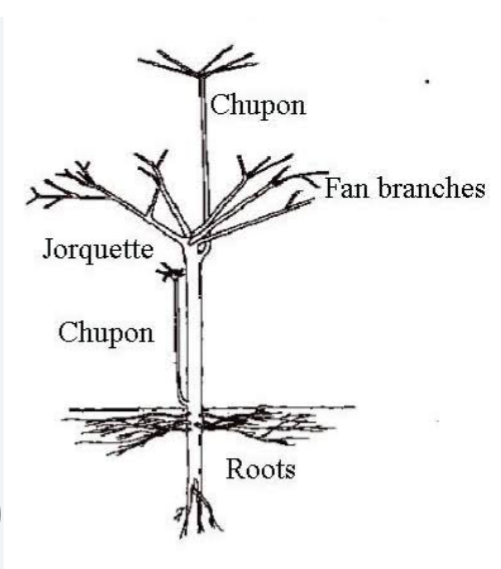
The chupon has slow growth and break into 5 when it dies. Another chupon will grow and break into 5. The first growth of the chupon breaks into 3 to 5 branches and stop. Another from the first branches grows rapidly, stop growth and break into 5 then the final break will occur.
Branches dimorphic ( The seedling of cacao has a determinate orthotropic shoot with a (2+3) phyllotaxis. Branch dimorphism is initiated after 1 to 2 years of growth at which time the apical meristem of the orthotropic shoot aborts and a pseudowhorl of plagiotropic branches is initiated from axillary positions in the shoot tip. ) with verticals of chupon growing from the trunk and the lateral branches or jorquette ( branches) growing from the chupon.
The various insects are involved in cocoa pollination. These insects include : thrips, ants, midges and aphids. There is self incompatibility in cocoa (fails to cross breed) which is genetically controlled in the gametophic and sporophytic system. This is to ensure cross breeding.
The influorescence are branches compacted into cushion( holds the flower) which occur only on older leaflets whorl of the main stem and firm branches and never unresent flushes (new branches with new leaves).
AGRONOMY OF COCOA
1. CLIMATIC REQUIREMENT : The bulk of the cocoa produced all over the world is produced within 10 degrees of low latitude and altitude ( hieght above sea level). Some are produced in Mexico and Brazil at 20 degree North and 30 degree South respectively.
Cocoa requires an average monthly rainfall of 150mm, which total to 1350mm/year (that is 150mm/month for 9months). The rainfall can be supplemented with irrigation during dry months.
It requires an optimum yearly temperature of about 25 degrees Celsius with a daily range of not more than 10 degrees Celsius. This temperature is necessary to initiate bud bursting.
Dry wind such as hamathan can cause dehydration of the floral organs resulting in failure of pollination. On the other hand, high air humidity is undesirable in cocoa because it favours spread of cocoa burst pod caused by Phytophtora palmivora.
SOIL REQUIREMENT : Cocoa is a tap rooted plant that thrive well in fertile soils. It requires a deep, well drained soil free from iron concentration. The soil must be high in nutrient content and the top soil must be rich in organic matter. Also, the soil must be clayey with range of pH from 6.0 -7.5, with availability of major nutrients and trace elements.
Cocoa trees are more sensitive to moisture stress than other tropical crops. They are also sensitive to water logging. While they can withstand flooding, they will not tolerate stagnant, water logged conditions.
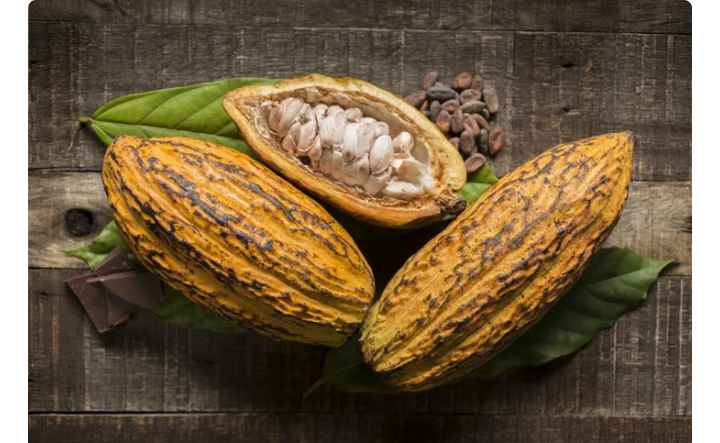
COCOA HUSBANDARY: The accepted approach is to plant cocoa in selectively thin forest. That is, complete clearing should not be done or cut traces or plant along traceses through the grown forest. Permanent or temporary shade and ground cover are to be established before planting cocoa. The general accepted spacing in West Africa is 3m by 3m. This makes cocoa one of the Agroforestry enterprise.
PROPAGATION METHOD: Cocoa can be propagated through seeds or vegetatively. For raising seedlings, seeds of mature pods are taken from high yielding mother plants. The mother plants chosen should yield more than 100 pods per year and should have medium or large green pods with an average dry bean weight of not less than one gram. Also, good quality seedling can be raised from hybrid seeds.
Cocoa seeds easily lose their viability after seven days of harvest. To avoid these, the extracted seeds should be stored in moist charcoal and then packed in polythene bags. This makes them store longer.
TRANSPLANTING: The best period of sowing the seeds of cocoa in nursery is December- January.
Cocoa seedlings can be raised in two types of nursery:
1. Ground nursery
2. Polythene bag nursery
In the ground nursery, nursery beds are made for planting the seeds. The seeds are planted on the bed at a spacing of 15cm to 16 cm apart. While in polythene bags, seeds are sown into 20cm by 12cm size bag. The seeds should be sown with the helium end facing downwards or are sown flat. The seeds should not be placed too deep in the soil.
The seedlings are ready for transplanting into the field after about 4 to 5 months in the nursery when the rain is steady. A week before transplanting, partial digging of the seedlings should be done. This will cut off some roots giving way for new ones to grow out ahead of transplanting. The seedlings are usually lifted with a boll of earth. When transplanting to a field far away from the nursery, the seedlings should be nakedly transplanted, however, with initial dippening in clay sorry to reduce evapotranspiration.
Seedlings in poly bags do not require any special treatment ahead of transplanting but should be allowed to rest for 7 days after transporting to the far field before actual transplanting. Transplanting Cocoa is a two men operation. One man holds the seedling in position while the other man removes the polythene bag and arrange the seedling roots in position, filling in the soil and firming it.
VEGETATIVE PROPAGATION : Large scale production of superior planting material is possible in cocoa through vegetative means like budding and grafting of which budding is the easiest. Seedlings of about 60-90 days are generally used as root stock. Both the root stock and scion must be of the same thickness and physiological age or else the process will fail. In the case of budding, Bud wood from chupons can be used.
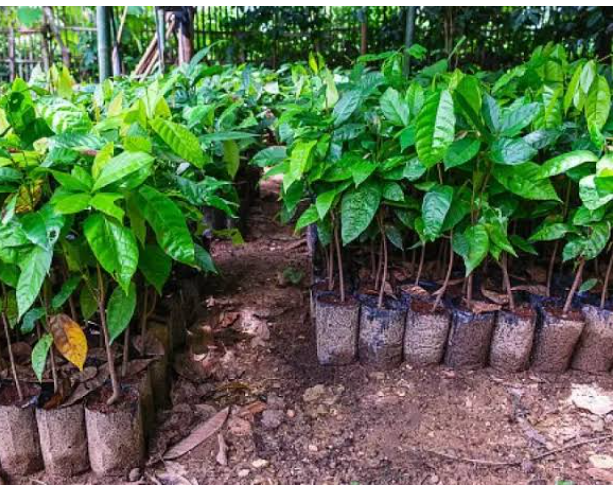
MAINTENANCE OPERATION
Application of organic matter is an all year operation in cocoa plantation which can vary with may factors such as climate, fertility of the soil, seedling age, plant vigour, and method of establishment.
a. INTERCROPPING: Cocoa can be planted as intercrop with other tree crops like coconut, Dadap (Erythnina lithosperma), Albizzia stipulate garden and in arecanut garden, provided the spacing of tree crops are sufficient to provide enough shade and the soil is suited to cocoa
b. WEEDING: In cocoa plantation, weeds are less controlled. The frequency of weeding depends on the amount of overhead shade and rainfall. For small size plantation up to 2 hectares, clean weeding is ideal. But for large plantation, row weeding thrice a year supplimented by atleast 4 to 6 slashing per year is adequate. Weeding reduces incidence of black pod disease due to better air circulation. It also controls pest. Use of herbicides like amino triazone, simazine, simazine mixed with amino triazone and para quart have considerable advantage and are considered economical.
c. MULCHING: Mulching is of two types. Plastic mulch and use of vegetation like grasses. Mulch should be applied before the onset of dry season. For dry grass mulch, a 15cm deep layer of mulch should be used with small area around the base of the seedling, hence, to reduce termite attack. The mulch is important for
i. To reduce losses of much seedlings
ii. It is an anti-erosion to reduce loss of soil fertility
iii. It conserve organic matter
iv. Reduce loss of soil water by decreasing evapotranspiration
d. SHADING: Temporary shade is needed to nurse the crop. Cocoa requires microclimate to survive and produce. The ideal nurse crop should be easy to establish. It also should provide a good overhead shade within a short period of time and the shade should last through out the year. They should not compete with the cocoa plant for moisture and soils nutrient like banana. And should be easy to remove when no longer needed. It should not serve as alternate host to insect pest and diseases. The spp of Sterculiceae and bombaceae should be avoided.
e. PRUNING AND TRAINING
Pruning is an important continuous operation in cocoa.
The chupon or vertical branch of the seedlings terminates at the jorquette when four or five branches develop. Further chupon develops just below the jorquette and continues its vertical growth till another jorquette develops and so on.
When the first jorquette develops at a height of 1.5m, the canopy will form at a height convenient for harvesting and other operations.
It is desirable to limit the tree at that level by periodic removal of chupon growth.
The second jorquette may be allowed to form if so desired. Operations like harvesting, spraying etc. will be easier if the height of the trees is kept at the second story level. Generally three to five branches develop at each jorquette. When more fan branches develop one or two weaker ones have to be removed. Similarly, overlapping branches also have to be removed for facilitating uniform light and penetration of every part of canopy. When more fan branches develop one or two weaker ones have to be removed.
BENEFITS DERIVED FROM SHADE
i. It extend productions life of the tree
ii. Prevent overhead bearing or die back . – Overhead bearing is when the crop produce excessively in a year and the following year did not produce or shortage.
– Die back is when intense heat of the sun hit the plant and the plant continue to die.
– Alternative bearing is when the plant produce every year.
– Yield manipulation include pruning the leaf to root ratio. Both must be thesame inorder for the plant to have normal bearing
iii. Give more even annual cropping
iv. Produce a favourable microclimate by reducing temperature of air and soil at high temperature and at low temperature, the normal temperature is maintained
v. May reduce pest and diseases. Too much of shading and humidity brings black pod disease
vi. Reduce evapotranspiration
vii. Leaf falls provide mulch, humus and nutrients because of shading effect.
viii. Protect organic matter of the surface layer from break down from exposure to sunlight
ix. Drainage and aeration is provided by root system or shade trees
x. Reduce weeds and keep out grasses
xi. Shade trees may provide firewood, timber and other useful products such as gum
PRUNING: It is sometimes done to rejuvenate old trees. It is a general accepted operation that is carried out to remove unwanted growth and maintain regularly shade trees which will enhance a well balanced firmly closed umbrella shade trees. Light pruning is usually recommended unlike heavy and unskillful pruning. Any injury caused during pruning impose diseases on the tree crop. Any cut branch wound should be covered with paints or use tarred sealing compounds. Heavy and unskilled pruning leads to yield reduction. Pruning removes low hanging, regenerate falling and damaged trees and broken branches.
REGENERATION: This is an important operation designed to maintain continuity of yields at whatever age of the cocoa plant. When storms damage trees, dormant buds will grow out to form chupon. Three spaced vigorously chupon at the base of the trunk should be maintained. While one or two should be eventually allowed as soon as one jorquette. Sometimes, earth is heat up around the base of new shoot to encourage regrowth of independent root system.
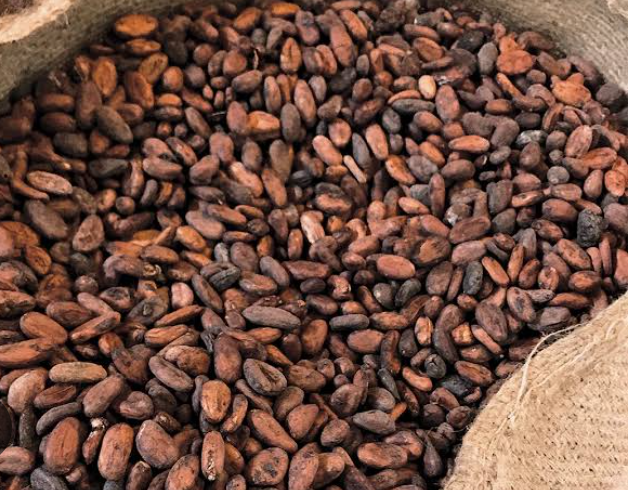
REPLACEMENT OF DEAD SEEDS
Most times in plantation, some seedlings are dead. Therefore, supply of vacant spaces or gaps is usually done during the first two running season after planting on new farms. The supply should be done early in the year. Adequate rainfall is needed during and after to maintain successful operation
FERTILISER APPLICATION: Application is increasingly becoming popular since virgin forest floor for Cocoa growing is exhausted. New cocoa plant are then established on secondary bush soil and the cocoa will now need N:P:K and boron fertilizers on new establishment.
A clean weeding is required on the field before application of fertilizer to prevent weed from utilizing or reducing the impact. Fertilizers is applied at circular band at a distance of 10cm from the plant putting on the soil surface. For mature cocoa plantation, when the canopy is close, litter thick and compacted. First of all, loosen the compaction before application of fertilizer and in this case, broadcast method is used for mature plantation without touching the trunk
HARVESTING: It takes 150 to 180 days from pollination to pod ripening depending on varieties. Harvest promptly and process mature ripe pods. Do not process unripe , diseased and damaged pods.
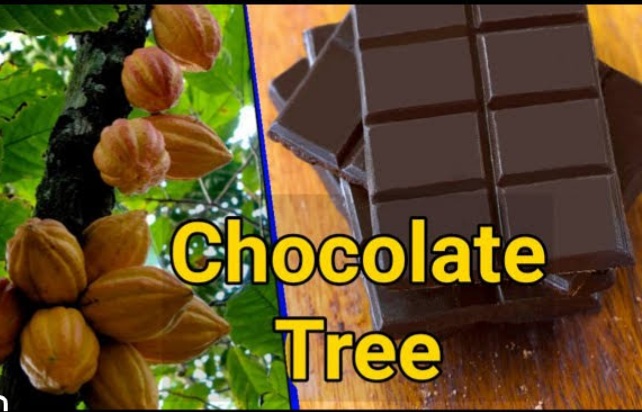
Production season should be noted. Main season is September to March. Light crop season is April to August. When harvesting, ensure regularity and frequency that will discourage ever ripen and losses due to disease and animals. Harvesting should be twice a month for the main season and once a month for the light crop season. Bad harvesting technique reduce yield of cocoa in subsequent years. Hence, use sharp cutlass or go-to-hell for high trunks and basket are required for harvesting.
